Alex Itsios's Blog, page 2
September 3, 2024
What Gamescom Taught Me This Year As An Indie Developer
It’s been a while since I last updated my devlog, and a lot has happened over the past few weeks. First, I had the incredible opportunity to attend Gamescom this year, where I was given a booth to present my game. Shortly after returning, I faced some personal and family issues that required my attention. Despite these challenges, I’ve had time to reflect on my experience at Gamescom, which I’ll share in this post.
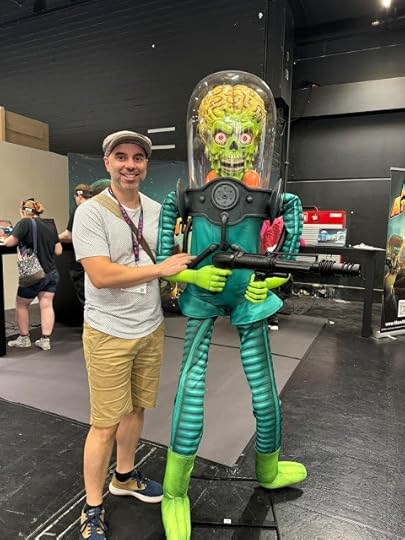
Now, let’s get into the nitty-gritty of my experience from Gamescom this year and whether it’s worth participating as an indie developer. First, let me clarify what I mean by "indie developer." This term is used quite broadly these days. An indie developer could be someone with no budget, working alone or with a small team, or it could refer to a team working on a AA game with a budget of $10 million. In my case, I’m referring to indie developers with little to no budget, and I’ll discuss what value Gamescom can offer for developers like us.
Gamescom Steam Festival
First and foremost, I want to mention the Gamescom Steam Festival. Most of the indie developers I spoke with at my booth received around 1,000 wish lists for their unpublished games from this event. This can be a significant boost if you’re just starting out, so I’d say this is one of the most tangible benefits of attending Gamescom. Unfortunately, I was unable to participate in the Steam event due to an issue with my application form, so I had the opportunity to find out how useful a booth is as a standalone service.
Types of Indie Sections at Gamescom
Gamescom offers two types of indie sections. The first is the Indie Arena Booth (IAB), where you apply as an individual game developer. By individual, I mean you're not applying as part of a delegation as it was in my case. If you're applying for IAB, Gamescom has a committee that reviews all the games and handpicks those that best fit the spirit of the Indie Arena. I want to emphasize "fit" rather than "best" because these games are chosen based on how well they align with the Indie Arena's spirit.
The second section is the Indie Area, where publishers or associations showcase indie games at their booths. In my case, I participated in the Indie Area through the Game Developer Association of Greece, which provided me with a free booth to present my game, Spellbound Hearts.
My Experience in the Indie Area
On average, I had about 50 to 60 people playtesting my game daily. Although I didn’t need extensive feedback, as Spellbound Hearts was released last year as part of the yaoi jam, and I had already received feedback, it was refreshing to see people playing my game and receiving direct input. Interacting with players is always valuable, even for a visual novel where gameplay feedback might be limited. For other types of games, I imagine the playtesting feedback would be even more valuable, especially regarding gameplay mechanics, controller responsiveness, and UI navigation. In summary, you'll get plenty of feedback from the event for sure.

What I was expecting, however, was more coverage from the press and streamers. I understand that my game is niche, but I hoped that other developers at my booth with more mainstream games would receive some coverage. Unfortunately, I didn’t see this happening to the extent that would benefit an indie developer as myself. Yes, some press members came by, asked questions, and took our business cards, but I haven’t seen any significant coverage or streams yet. We did get some attention from local Greek gaming websites, but this could have been achieved through other means, such as a direct email or reaching out to them through social media.
Regarding publishers, only Greek publishers approached us at our booth. I didn’t see any other developers being approached by publishers, except for those from Greece. However, Gamescom does offer a separate business area where developers can meet with publishers, co-developers, and others to discuss their projects. I had the opportunity to pitch my new game, Parallel Pulse, to some publishers there. Being in the business area is definitely valuable if your goal as an indie developer is to connect with publishers.
Is It Worth It?
Now, the million dollar question: is it worth participating as an indie developer in Gamescom, the biggest game dev event in the world?
All in all, it is worth attending Gamescom as a budget-constrained indie developer only if someone else is covering your expenses, such as access to the Steam event, business area, and booth. If that's the case, then absolutely, go for it. However, if you’re operating on a tight budget, participating could cost you around $5K as an individual indie developer. In that case, I don’t think it’s worth paying that budget out of your pocket, especially when those funds could be better allocated elsewhere.
Gaming events like Gamescom are more of a marketing tool rather than a sales channel. You need a marketing strategy, and as we all know, marketing is costly and not for indie developers as myself.
This was my second time attending Gamescom, and the reason I wanted to write this post after my second experience is because the first time I went, the experience was so overwhelming that I couldn't judge things as objectively as I should have. I still believe that if you manage to find a YouTuber with a big audience who could stream your game, it could be a huge win. But after being at Gamescom for the second year, I haven’t seen this happen for the vast majority of indie developers, and it’s not like you can’t reach out to them influencers via social media or email.
Have you attended other game dev events? I’d love to hear about your experiences in the comments.
I'd like to close my post with a video reel of all the games of the Greek Expedition.
August 19, 2024
Painful Cuts I Had to Make to My Game
As much as we hate them, cuts in game development are often necessary. If I’m being honest, I’ve never worked on a project where we didn’t have to make some tough decisions. You start with bigger aspirations—dozens of sprites, backgrounds, and CGs—only to realize that everything takes an insane amount of time and resources. Parallel Pulse was no different.
The original vision for the game was something akin to TWEWY in terms of combat, but with a narrative more aligned with the Persona series, where you bond and hang out with friends. The game started as an action RPG, and until mid-May, I was set on this approach. But then reality hit—with each sprite taking way more than what I had initially thought it'd take.
In a previous devlog, I gave you a glimpse of how much effort goes into creating a single sprite sheet. It goes without saying that this became a nightmare for me—and not just for the main character but for each enemy as well. Every enemy needed at least three animations, while Laios, the player character, required at least 15 combat animations for various actions like attacks, taking damage, and more. It was overwhelming.

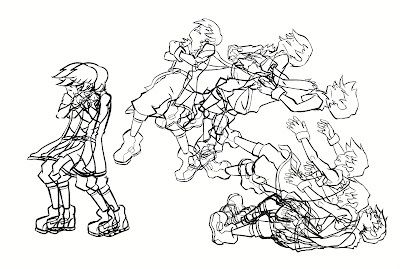 After returning from TheComicCon Thessaloniki this year, where I attended a tabletop game design workshop, I realized that continuing with an action RPG would likely end in failure. The sheer amount of work required for various animations
After returning from TheComicCon Thessaloniki this year, where I attended a tabletop game design workshop, I realized that continuing with an action RPG would likely end in failure. The sheer amount of work required for various animations and VFX was beyond our capacity. That’s when I decided to pivot to a turn-based RPG.
While this decision was comforting to most of the team, some believed the game needed to be fast-paced with action elements like before, and I couldn’t agree more, but we had to be realistic.
For the next few days, I struggled to find a system that could be turn-based while retaining some action elements. Fortunately, one of our artists proposed a game mechanic that draws inspiration from a mobile turn base RPG. While that game is indeed turn-based, it also incorporates action RPG elements in a fast-paced manner. After agreeing on the course of action we'd take, something unexpected happened: we realized we now had more flexibility with our game. Let me explain what I mean by this.
In our initial concept, having AI-controlled sidekicks seemed like a good idea, especially since The World Ends with You successfully handled two characters at the same time. However, this idea quickly became problematic when considering different hardware and design considerations for consoles and PC. And compared to The World Ends With You, having AI teammates often isn’t fun for players, so this feature was easily scrapped.
By switching to a turn-based RPG, we hope to offer a wider cast of playable characters, which not only makes more sense for the narrative but also enhances the player experience.
Another cut was the concept of having visual novel backgrounds for each environment. While doing early UI concept art, we realized that the existing backgrounds, where the player navigates, looked great without the need for additional ones. While we haven’t completely ruled out adding more backgrounds, it’s likely that we’ll stick with what we have.
The result of these cuts was not just freeing up time for the art department and myself but also giving us the opportunity to explore more monster designs and introduce greater variability throughout the game. Although our game design document is still in a high-level state when it comes down to combat, I believe there’s now a good balance between The World Ends with You and Persona gameplays.
In the end, these cuts not only decreased the overall scope of the game but, in my opinion, made it better. The only trade-off is that action RPGs are generally more streamable than turn-based RPGs, but it's a small price I have to pay.
August 11, 2024
Do Most GameDev YouTubers and Influencers Create Unrealistic Expectations for Indie Developers?
Our culture is characterized by the pursuit of perfection, and video games are no exception to this. As the video game industry has grown, games have become increasingly polished and sophisticated. With this growth, smaller solo or indie studios have emerged, giving them the opportunity to make a living from their games.
However, to make a sustainable living as an indie, you need fast development cycles. Imagine working on your game for six years, only to release it and see minimal profit. You might realize it wasn’t worth the time and switch careers. Or, on the other hand, you might dream of making a living from video games but realize you can’t sustain yourself for four to six years to complete your passion project, leading you to abandon the idea altogether.
What if you followed an approach similar to that of game developers in the 80s and early 90s? Back then, development cycles typically lasted 6 to 12 months, and many games still managed to turn a considerable profit. Of course, there were instances where games flopped, but this didn’t spell the end for developers—they had time to develop another game and another. Having consecutive failures might lead a developer to close shop, but that’s another story. The key point is that those indie developers understood that the only way to make a living was by having shorter release cycles.
But today, GameDev YouTube channels showcase how the game development process unfolds, often lasting four to six years. Most of these developers don’t make a living from game development; they earn from YouTube or have another income. For them, the development of the game is more about the journey than the process of making a living. And that’s totally fine. As a consumer, I enjoy watching these types of videos.
The issue arises when indie developers set unrealistic expectations for themselves based on what they see around them all the time: perfection and long development times. While YouTubers can be a great source of inspiration for many, including myself, they might unknowingly be setting you up for failure. Sustaining yourself over a four to six-year period to make a game is highly unrealistic. In most cases, life gets in the way, and it’s highly likely that the project will eventually be abandoned. I’ve seen quite a few people spend six years developing a game only to barely recoup their expenses. What’s worse is that they genuinely want to be indie game developers.
The approach of many indie developers—aiming to create the perfect game—sets unrealistic expectations. As a solo developer, you usually outsource some parts of the game to others to get it finished. You can’t compare yourself with big AAA titles or even larger indie titles. The reason we see so many games released by studios or solo developers is that they’ve dedicated an enormous amount of time—six years or more—to a single project. You might think you’ll hit it big and be set for life, but sustaining that level of effort for so long is practically impossible.
The games we often see highlighted are the exceptions, the success stories, similar to startups. You see only what's being successful, but we never find what happened to the other 95% that failed. The game dev industry is the same: there are countless other games that flop along the way or never even make it to release. After my experience with Parallel Pulse, I want to focus on shorter release cycles that don’t last more than 12 months. I got caught in the loop of developing my dream game, only to realize it might take three years to complete from the day I started it.
Let me give you an example with the player character sprite sheet. The game uses an 8-directional approach to mimic the style of The World Ends with You. Here's how many sprite sheets we had to create just for movement:








And you might be thinking that some directions don't require much work, like the left/right ones , and you're right—but the character is asymmetric, so minor details like a pocket need to be visible. If you're wondering why we created an asymmetric character in the first place, the answer at that time was simply that it looked cool and was what we wanted to make. Of course, knowing what I know now, I wouldn't take the same approach again.
But this isn't the end of the story for our player character. The player character needs to have 8-directional static idle poses, as shown below.
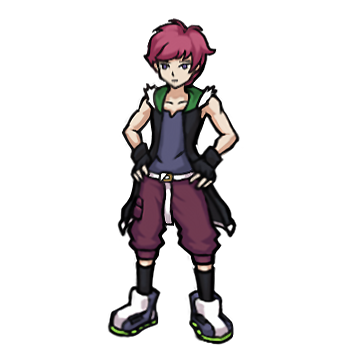
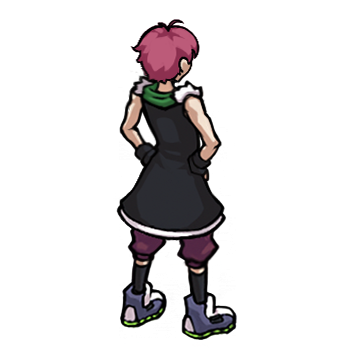
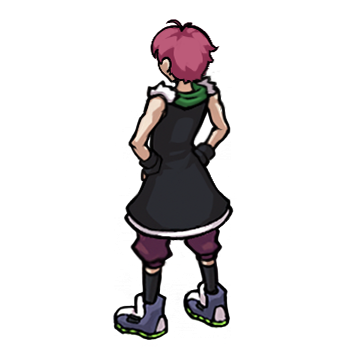
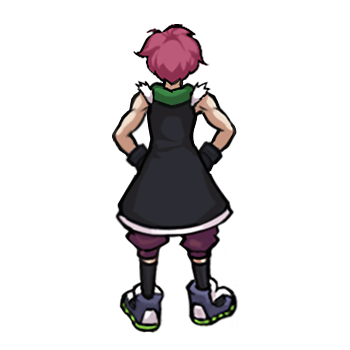
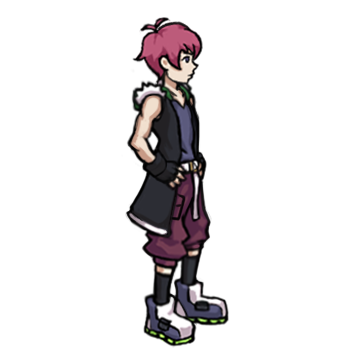
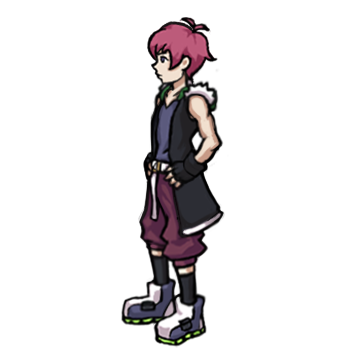
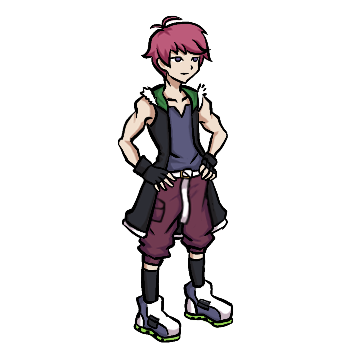
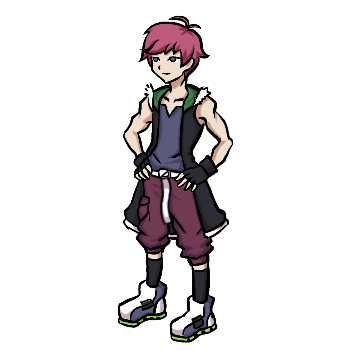
And, of course, for the quality of game we're aiming for, static poses alone wouldn't suffice, so we went ahead and created not one but three idle animations. So far, we've only completed one direction, but we need to make this 8-directional to ensure smoothness.



As you can imagine, these seemingly simple tasks skyrocketed the development time. It goes without saying that having an NPC follow the player became impossible because we would need to go through the same amount of work for another character to make the experience feel organic. But here's the thing: it's an indie game. We can't do what the team at Square Enix did with The World Ends with You, so this idea was immediately scrapped.
Subsequently, we decided to shift from an action RPG to a turn-based RPG because the number of animations we would need was simply too much, and the game would likely never see release.

Lessons learned—going forward, I plan to follow a moreminimalistic approach for my future games.
August 7, 2024
Rev Share Reality Check: Why Splitting Profits Is a Game Developer's Nightmare
I won't deny that revshare projects seem very appealing tothe majority of people, including myself. I started doing my first rev shareprojects when I wrote my first books. I didn't have much experience back then,and having another person check your manuscript didn't seem like a bad idea,especially in my case since I'm not a native speaker. Fortunately, I was luckyenough to have a very experienced co-writer as my partner, and the books wewrote were great, let alone the partnership being smooth. Unfortunately, thingsdon't go that well in most cases, and if you’re thinking of doing revshare ingame dev, well, the challenge is on another level.
Most rev share projects I've joined over the years startwith a phrase like this: "We're going to split profits evenly," orthe person pitching the idea holds ownership of most of what's being produced.As we all understand, starting with the above mentality can never work out. Ifmy kid came and told me about it, I’d say it’s a bad business deal. But when itcomes down to making a rational choice yourself, you’ll do exactly what allpeople do. Let me elaborate.
I've never heard of a revshare project working without aproper plan. I must confess that even though I participated in several revshareprojects in the past, I did it knowing that the project would fail down theroad. You might be wondering why I participated in these projects despiteknowing they would fail. The answer is simple: The concept looked cool, and Iwanted to gain more experience. Even if the project failed, I would get theopportunity to expand my skill set and knowledge. Because, let's face it, inmost cases, rev share projects are on the same level as free projects in termsof profitability. I participated in jams and free projects only to advance myskill set, and rev share projects don’t differ that much for me.
I must confess; however, that revshare projects have a99.99% chance of failing. I will summarize why this is the case compared tofree projects and why I always preferred doing free projects. The deal is nevergood enough, and some people will do most of the work while others will slackoff. As you can understand, this creates disparity between the members becausethose who work more want a bigger cut of the pie – and rightfully so. What mostpeople don't realize is that most beginner projects have very little commercialvalue, and the chances of actually making a profit are negligible. The realityis that your first projects will generate below $500 in gross revenue. Is itworth going through all the trouble? Hell no, but people think their idea willmake millions without realizing the actual work that needs to be put into agame dev project. Therefore, when you gather people who care mainly aboutmaking something good and advancing their skill set, without caring for profit,the chances of completing a project are way higher, and you don't have to gothrough the painful process of negotiating revshare.
By all means, I'm not saying that people who want to makerevshare projects are bad in nature. It’s they think their amazing idea willgenerate a lot of revenue.
And if you’re still wondering why revshare worked for mybooks and why can’t it be replicated to game dev? Well, it's different to haveone person discussing the production and marketing of your book, but imaginedoing this for a complex project that requires 15 or 20 people working on it.It's pretty obvious that from a production standpoint, this won’t work.
I’m sure that some people out there have found a way to make rev share work with smaller teams, but I’ve never met one. Have you? Or is it simply that because we've heard people say rev share works, it has become an accepted belief?
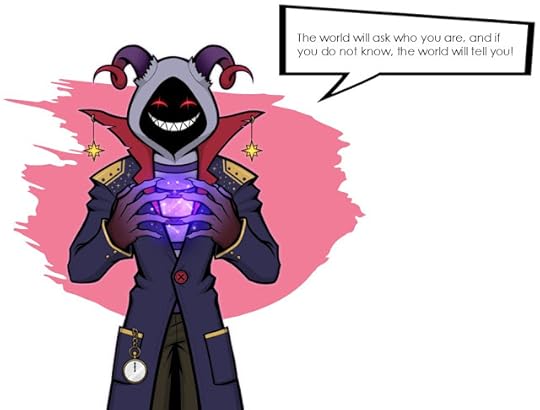
Why Did I Decide to Make My 2D Persona Inspired Game with Unreal Engine? Was I Right in the Head?
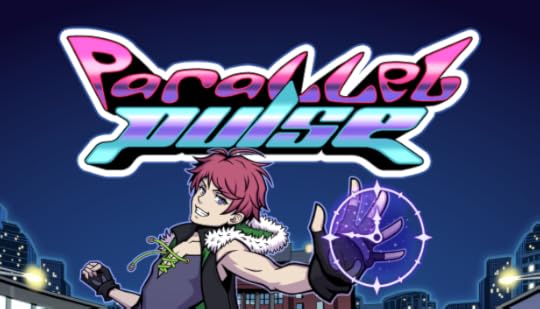
Let's face it: there are several game engines out there and choosing the right one can be tricky. Until a couple of years ago, I was juggling between Unreal Engine and Unity. Despite most of my friends who have worked in AAA games suggesting I go with Unreal, I always thought Unity had the most appeal because it was advertised for indie game developers. Then Unity messed up their pricing, and everyone suddenly started switching to Godot and Unreal Engine. Not many professionals changed though, and I’ll get into it below, but most hobby indie developers, especially YouTubers, saw this as a threat to the gaming community, and rightfully so.
When this Unity mess happened, the decision was clear to me as to what game engine I should start learning: Unreal Engine. The game I'm making right now is a 2D JRPG inspired by Persona and The World Ends with You, but at some point in the future, I imagine I will switch to making 2.5D and 3D games. To be fair, Unreal Engine has a clear advantage when it comes to 2.5D and 3D games. More or less, Parallel Pulse is like a hallway for me to transition to full 3D games. It's not because I don't like 2D games—quite the opposite, 2D games hold a lot of appeal to me—but at some point, I want to make 3D games to better express the experience for some games I want to develop.
Some of you might say that Unity or Godot can do pretty much what Unreal can, but at the end of the day, I've seen firsthand that Unreal Engine’s physics can't be compared. It saves you a ton of time and headaches. Blueprints allow you to create games quickly, and there's no shortage of resources and tutorials on how to implement pretty much anything in 3D. Unfortunately, most online tutorials I've watched usually scratch the surface as to which engine you should use. If you are a hobby developer and you're planning on developing simple games, pretty much any game engine will do the work. But if you want to be a full-time game developer making your own games, then the choice becomes more obvious.
This means you want to have your game in front of as many people as possible. As we all know, PC gaming comes last after console gaming and mobile gaming. Since console gaming is nearly twice as big as PC gaming and gives you the ability to bring your game in front of most gamers, it's a no-brainer that the game engine you use needs to have all the tools to export your game for consoles. This means that game engines like Godot are automatically excluded for me. Don't get me wrong; I really like the engine and played a bit with it, and it's insane that you can pretty much code an entire game using your tablet, but it's important to me that the game engine has native capabilities to export to consoles. If that wasn't the case, then probably Godot would be my preferred choice for 2d games. I understand that several of you might think that you can find a company that can port your game for $10K or you can buy the tools needed, but let's be realistic here. Most of us don't have that amount of money to port the game in the first place. With GameMaker, Unity, and obviously Unreal Engine, things are fairly simple. Yes, you need devkits and access to the developer’s SDK, but it’s not that expensive.
What makes Unreal Engine even more attractive for game development in general is their pricing model: after you get $1M gross revenue from your game, you have to pay the engine 5%. For most indies, we’ll never surpass that amount of money, so essentially you're using the engine for free. Unity’s price model is ok now, but they've proven you can't trust them, so in my case, Unreal Engine was the obvious solution.This doesn't mean that Unreal Engine is the best for everyone—every person has their own preferences and reasons. In my case, I chose Unreal because of where I think my audience exists: in consoles. For example, if I wanted to make a mobile game, then Unity would be a no-brainer because they have the best support for mobile games. It's obvious that Unity doesn’t care much about PC and console games since the majority of their profit comes from mobile gaming, and thus Unity’s price model is focused on mobile games.
Does this mean that I will stop making games in other engines? For my personal, commercial projects, it’s highly likely I’ll be mostly using Unreal Engline, but for everything else, Ren'Py will always be my first choice. As you might have seen, I primarily make narrative-heavy games, and that engine is built specifically for it. You can create narrative-heavy games insanely fast, and believe it or not, I wouldn't change it for any other game engine if it wasn’t for console porting. I hope I gave you some insight into why I made this decision. If you are thinking of following a professional game development path, then console porting will probably be part of your business strategy, and you might want to consider which engine works best for your needs.
August 6, 2024
From Inspiration to Reality: The Making of my Dream Game (Parallel Pulse)
After several months of developing the game, it's finally time for the first devlog. As you might have noticed, the game takes inspiration from Persona and The World Ends with You. To be honest, I was a bit hesitant about starting this devlog. The reasons are basically personal, and I wasn't exactly sure when it would be ideal to start something like this. I understand the reasoning of most people that you should market your game from the get-go, but there's no guarantee that your marketing efforts will pay off. As an indie developer, things are more complicated since you have to juggle between many things: from managing your team to actually developing the game. Time is precious, especially when you’re in your late 30s, with a kid ^ ^
Why did I start this devlog?
Despite my initial concerns, I decided that starting a devlog would benefit me. Not necessarily because of marketing, but mostly as a way of expressing what's on my mind. It makes me feel better, almost like going to a psychologist. So, I want to record the development of the game, see how things progress, and perhaps provide a helpful resource for other developers trying to make their games.
So, back to Parallel Pulse and the main concept behind it. I would characterize the game as a turn-based JRPG. Although the mechanics are closer to Persona and its story logic, it mainly takes visual inspiration from the TWEWY.
TWEWY & Persona have been my main sources of inspiration
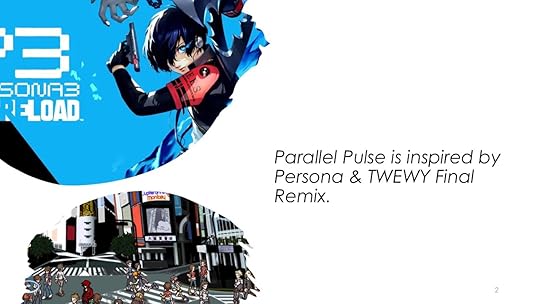
Back in 2008, internet was limited, same went with information online, and when I bought TWEWY for the DS, I didn’t think much of it when I saw it on the shelf. I just looked at the back and decided to buy it. I wasn't expecting much, and wasn’t even sure if I’d like it, but when I first launched the game, I was immediately blown away. From the unique aesthetics to the innovative mechanics, it was a game that pushed the hardware limitations of the DS to the limit.At the same time, one of my best friends had bought Persona. Although I didn't play the game when it was first released (in 2008 in EU), I would go to my friend's house and hang out while he played. I must admit I enjoyed watching it more than playing it at the time.
And now we go fast forward to 2023 when I decided I wanted to make a game that takes inspiration from both of my favorite JPRG games. I never expected to become a game developer, let alone make one of my dream games. Although The World Ends with You had an amazing story, I decided to go with a more entertaining approach, similar to Persona. The main inspiration behind this is the character art being more extroverted and because making a game like The World Ends with You would require more time bandwidth. Let me clarify what I mean by this. Back in 2008, games weren't released in bulk as they are today. When you bought a game, you most likely made the best out of it, finishing it and dedicating a lot of hours to it. TWEWY starts with Neku, an introverted teenager who isn't the most likable character. However, as the game progresses, Neku transforms from an annoying brat to a caring person. Themes like friendship and love are explored This transformation takes a lot of story beats, with each character having their journey and dreams.
My point is that 15 to 20 years ago, stories had the luxury of more time bandwidth. Same went with books. You could start a bit slower. Nowadays, that's not the case, and you need to capture your audience's attention from the get-go. At the same time, I wanted to incorporate dating simulation elements similar to Persona.
Just a small note here: I admit that I wasn't playing Persona for its scenario; it was mostly because of the interactions with friends and romances.
Game Plot & Character Cast
Similar to Persona & TWEWY, the plot takes place in a contemporary environment where spirits exist and grant wishes by forming contracts with the living. Unfortunately, these spirits are prone to corruption if the wrong rumors spread about them. Our hero is caught in a war between spirits and the Netherborn, humans who have overused their spirit-granted powers.
The main characters of the game are Laios, Amelia, and Oliver, three schoolmates caught in this war. The player is granted powers and needs to uncorrupt the spirits of their school while surviving the trials posed by both the spirits and the Netherborn.
Design and Development Decisions I had to take early on
When I started developing the game, I wanted to create an action RPG experience similar to TWEWY; however, I soon realized that the barriers were enormous, so I quickly decided to switch to a turn-based RPG. I probably took this decision on a whim when I went to Comicson Thessaloniki 2024. There was a workshop about game design, and there I realized what I was attempting to make wouldn’t work. Some people think that action RPGs are easier to make, and this might be the case for 3D projects. For 2D projects with hand-drawn sprite sheets, the challenge increases because you have to create animations for every single attack, different VFX, and various states for enemies. It’s more efficient to go with an old-school approach with turn-based mechanics. The AI is simpler, and it's easier to prototype on paper before implementing in-game. In summary, it would have been impossible or at least way more time-consuming to complete this project as an action RPG. Fortunately, we iterated relatively quickly and switched to a turn-based RPG version and no time was wasted in developing mechanics or assets.
Development Status and Future Plans
Currently, the game is in the preproduction stage, and we're aiming to release a vertical slice at the beginning of 2025. To be honest, I didn't expect the scope to expand so quickly. When I realized it, I immediately tried to scale down, especially with the combat system. Some unexpected challenges involved the game's art. TWEWY has unique background angles, which affects sprite behavior. Another issue is creating camera bounds and adjusting the camera for internal locations. Unlike TWEWY, which takes place mostly outside, I wanted to showcase the university's interior. This created a ton of issues with collisions as well as the camera system. I must admit that I'm not planning on releasing a game of this scope in the near future. Lessons learned!
The unique mechanics of the game haven't been fully fleshed out yet, but rumors will play an integral part in both the story and the gameplay. As I mentioned before, rumors can shape reality. Imagine spreading a rumor about an enemy that changes their behavior—this is essentially what happens in our game. I can’t reveal more now, but I’ll make sure to flesh out these parts in our Game Design Document as the game is being developed.
That being said, the main sprite sheet for the hero is nearly complete, and we are in the beautification and polishing stage. We've decided on an 8-directional approach similar to TWEWY. Similar to both Persona and TWEWY, the environments will be vibrant with life, with NPCs walking around, making the experience organic. That being said, most of the backgrounds are already completed and all locations will be functional by the end of September.
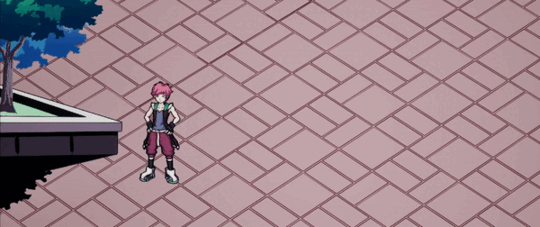
Developing the initial outline for the vertical slice of the game was also a challenge because I had to consider the mechanics while they were being prototyped. The script is in good shape, but it will likely go through iterations. At least the artwork is in an advanced state, and I have most of what I need to create the dialogue system, which is the next on my list to develop.
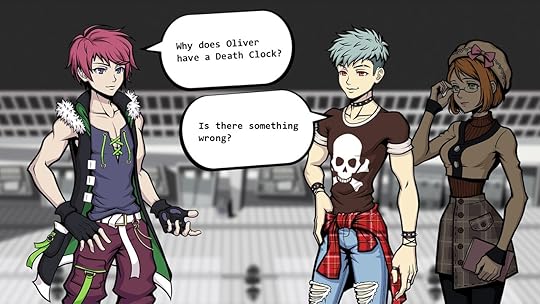
And that’s it, I guess. Thank you for following along, and I appreciate your support and feedback as we continue this journey. Don’t forget to follow my account and like this post!
May 6, 2024
The Best Marketing You Can Do for Your Game Is to Make It Great!
It all started with my decision to forgo social media for my indie game dev projects back in 2020...

If you're an indie game developer, you've probably came face to face with the following dilemma: Which social media platform to use to promote your game. Websites and social media platforms often dominate the landscape, seaming serving as the only go-to tools for reaching out to your audience and building a community. Also, experts of all kinds will tell you that you need to have a presence everywhere since everyone is doing it.
Prior to Covid-19, I can't recall a social media platform where I didn't have a presence. I was everywhere; however, as time passed I started questioning the effectiveness of social media, and for a valid reason: creating content for most social media platforms now brings limited (if any) organic reach and impact. At the same time, you need to be kept up to date with algo updates and changes. An account that appears successful one day can vanish into nothingness the next, leaving you with nothing but wasted time and effort. Simply put, this isn't a sustainable business model.
When I started developing my indie projects, the decision was clear for me: I should prioritize developing my games instead of wasting time developing content for social media. If you're a solo game dev or a small team, it's just way more practical to allocate your limited time and energy on actual game development rather than "investing" it in social media management. Managing multiple social media platforms at the same time requires a lot of effort, and these platforms are smart enough nowadays to understand if you're using a distribution platform to automate the process.
Can social media drive some traffic to your game? Sure, it can.
Is it worth the time effort? Honestly, it’s not. It's a massive waste of time for solo devs and single-A indie teams.
If we look at it objectively, social media’s effectiveness has diminished over the years, and organic reach is pretty much dead. The average reach for each of your social media posts is below 10%! And we know what reach means—most of the time, people don’t even glance at your content. When folks are scrolling through their feeds, they rarely pay attention what's thrown at them. Now, imagine trying to convince people to follow your link, land to your steam page, and Wishlist your game. I’d say it’s practically impossible to generate any real leads organically at this point, not with the way most people are doing it.
Today's entertainment landscape is about more than just your game versus others'. It's fundamentally about gaining attention. Let me elaborate on this a bit. We often think our games are competing against other games, but in reality, they're competing for people's attention. A person might prefer to spend their time hanging out with friends, watching a movie, or even eating pizza. All these activities fall under entertainment, and believe it or not, people nowadays have to prioritize what they want to do with their time: play a game or eat pizza with friends.
This reality means that as developers, we're not just trying to make a game that stands out against other games; we're trying to create an experience compelling enough to be chosen over other activities. It's a broad competition for engagement in a world full of options.
Where your focus should really be is on developing your game! Yup, you heard it right.
The indie games that dominate steam right now, deserve the spot they gained.I recently watched a video from Sasquatch B Studios about why most indie developers fail. The YouTuber explains that the indie games that currently dominate Steam truly deserve their spot, and I agree 100% with that statement.
Back in the day when I was writing and publishing books on Amazon, I noticed that fellow indie writers succeeded for three main reasons:
Rule n1: Write for market,Rule n2: Create amazing content,Rule n3: Be consistent.It might be obvious, but more than often you'll find yourself caught up in non-essential things, like figuring out how to promote your book, when in reality what matters are the three fundamental rules I mentioned above. It doesn't matter how good your book cover is or how catchy your blurb is if the readers start bombing you in the reviews.
My point is that the best marketing you can do is to make a great game! If the primary material isn't worth it, the truth is that it won't take off, and all the effort you put into it will be for nothing.
And I can hear you asking: "Should we just make a game and do nothing to promote it?" Of course not! You should promote it, but your primary focus should be on developing the game itself, and worry about the marketing when you have something decent to show.
 For the initial concepts of Parallel Pulse, we were thinking of having monster / beast traits for the characters.
For the initial concepts of Parallel Pulse, we were thinking of having monster / beast traits for the characters.With Parallel Pulse, I haven't done any marketing so far, but I'll begin promoting it over the next few months using the following approach:
Create a Steam Page: Having a Steam page is essential so players can wishlist my game, and it should be the first step you do to promote your game. Without a landing page and key art, creating buzz won’t lead to results—players will forget about the game the moment the scroll down, unless they can wishlist it.Identify my Audience: Like writing for a specific market, you need to know who the target audience is and focus on them. My game is inspired by TWEWY and Persona, so relevant subreddits, Discord servers, and Facebook groups centered around those games are the perfect places to gauge interest. To enhance results, I'll probably start doing FB & Reddits ads, to lead more people to my steam page and improve wishlist numbers.Focus on an Untapped Niche: I started making Parallel Pulse because I always wanted to play more games like TWEWY. But since it's both novel and niche, AAA studios never really had the chance to make another game like it. This makes this niche a sweet spot for a solo developer or small studio because it's profitable and less competitive. Being a part of these communities of TWEWY players because I genuinely love the game, makes it easier for me to know what my audience will enjoy.Reach Out to YouTubers: There's a handful of YouTube channels that cover TWEWY games exclusively. That niche following is exactly what I need, so I'm planning on reaching out to them and collaborate to promote my game, even paying them if necessary.And here you have it. A simple yet effective marketing strategy to promote your games. Have you tested something else that worked? Please share in the comments.May 4, 2024
Low fidelity games aren't low quality
 Laios: The protagonist of Parallel Pulse
Laios: The protagonist of Parallel PulseIn the gaming world, there's a common misconception that low fidelity (lo-fi) games lack quality compared to their high-fidelity counterparts. Let me set the record straight based on my own experiences as an indie developer. If you're aiming to create a profitable game, sometimes embracing low fidelity is your best bet. Think of fidelity like the type of road you choose to build: just as you can have both high-quality and poorly maintained dirt roads, so too can you have highways that range from impeccably smooth to dangerously neglected. The key difference lies in the level of fidelity. What I'm getting at is that specific niches in the gaming market don't mind if your game employs low poly graphics or simple 2D designs, as long as the game loop or story captivates them.
Let's first define what we mean by low fidelity games. These types of games typically feature simpler graphics, fewer animations, and a minimalistic design. While these characteristics often stem from budget constraints—common among small or no-budget projects—they can also arise from deliberate artistic choices. Some developers opt for lo-fi aesthetics to harness the charm of older technology, like pre-rendered graphics, or to make a distinct artistic statement. This blend of old and new can yield not only unique and engaging gameplay experiences but also prove quite profitable in certain niches of the gaming market.
Let's delve into a few examples of game developers who have carved out successful paths:
Coffin of Andy and LeyLey: This game explores complex family relationships, particularly between siblings, but in a uniquely twisted narrative. The developer uses the game's mechanics and story to delve deep into the emotional and sometimes dark aspects of familial bonds, setting it apart in the indie game space.Chilla's Art: Known for their distinctive horror games, Chilla’s Art employs a unique art style and aesthetic that set their titles apart from mainstream horror games. Their approach to visual storytelling and atmosphere immerses players in a deeply eerie experience, enhancing the traditional horror gameplay.Euphoric Brothers - Garten of Banban: This game proves that even short experiences can be highly profitable. Lasting about 15 minutes, it plunges players into a bizarre kindergarten setting where the MC searches for their children. Despite its brief duration, its engaging narrative and unique setting captivated a large audience, turning a quick playthrough into a profitable venture.Vampire Survivors: I first encountered this game when it was a featured but free title on Itch.io. Its addictive gameplay quickly caught the attention of many, including myself. Vampire Survivors exemplifies how a game with seemingly simple mechanics can captivate a massive audience, becoming one of the most profitable indie games in recent years.The list could go on with examples like the above, and I'm sure that luck and timing played a role in their success, but my point is that these examples highlight that low fidelity does not hinder a game's success but can actually enhance it by focusing on what truly matters: engaging content.
What's driving players to engage with low fidelity games though?While many gamers gravitate towards AAA titles, there's a growing curiosity about niche, indie games that break the mold. Several factors are making players to step away from mainstream games and explore indie games, but I'll focus on the most prominent ones:
Nostalgia: Gamers like myself, who have a fondness for the past, are drawn to games that echo the retro style of previous decades. These titles evoke memories and offer a sense of familiarity that’s comforting and enjoyable.Creative Storytelling: With fewer resources tied up in high-end graphics and technical complexities, indie developers can focus their efforts into creating rich, compelling narratives. This shift allows for deeper storytelling that often is lost in graphically intensive AAA games.Focus on Mechanics and Gameplay: Many popular low fidelity games prioritize robust, addictive gameplay mechanics. This emphasis on the core play experience rather than flashy visuals often results in more engaging and replayable games.How does all this relate to my strategy?Some time ago, I began developing Parallel Pulse, an action RPG inspired by games like TWEWY and Persona. Visually, it bears a strong resemblance to the DS version of TWEWY. As you might expect, the project's scope expanded significantly, posing a challenge given my team's capabilities as well as my own. While creating this game is fulfilling a dream and I believe releasing it will significantly advance my skills as a game developer, I've come to realize the scale of such a project isn't something I plan to undertake again soon—if ever.
 University: The main location of Parallel Pulse
University: The main location of Parallel PulseMoving forward, my strategy is to focus on smaller games that require fewer team members—just a composer and an artist, and perhaps someone to handle UI art. This approach will not only shorten development times but also reduce the overall time and resources needed. This shift aligns perfectly with the advantages of low fidelity game development, allowing me to leverage the benefits of simpler, more focused game creation while reaching a niche audience that can bring back profits that can sustain me.
There's a foundational reason why I'm adopting this new approach moving forward. Many indie developers find themselves locked into multi-year projects—imagine spending five years developing a single game then see it flopping. The primary challenge with such lengthy timelines is the inability to predict market trends and shifts. This unpredictability is a significant risk, I'm not willing to take moving forward, especially with the way the gaming market is right now.
That's why I aim to limit future game development to a span of 3-6 months. This timeframe is not only feasible; it's strategically sound. Within a few months, indicators such as wishlists and coverage by YouTubers can provide early signals of a game’s potential success. If a game isn’t gaining traction or outright flops, the loss is confined to just a few months of effort, rather than years.
By reducing development time, I can adapt more swiftly to the gaming market’s dynamics and avoid the heavy costs associated with longer, uncertain projects. This approach allows for more experimentation and frequent releases, increasing the chances of hitting on something that resonates well with players without the commitment of a multi-year development cycle.
How am I planning to implement this new strategy?As you may have noticed from the games I’ve been involved with, I have a strong affinity for narrative-heavy games, particularly those that incorporate elements of horror. My plan is to initially create a game during Spooktober game jam, to gauge interest and traction. If this prototype shows potential, I'll proceed with full-scale development.
Interestingly, I’ve observed that many people who typically don't play visual novels become engaged when simple gameplay elements are introduced. For example, adding a navigation system with sprite sheets can significantly deepen the player's experience. This gives players the illusion of choice, allowing them to decide which rooms or areas to explore, despite the story's linearity. It’s a subtle yet effective way to enhance engagement in a narrative-focused game.
For my upcoming project, I’m considering crafting a horror game that explores the complex dynamics between children and their parents—but with a dark twist. The primary game mechanic will involve a character moving in four directions within the confines of a house, attempting to escape. While the game will feature minimal mechanics, the narrative will take center stage, driving the emotional impact and hook of the game.
I plan to develop the initial version of the game within about a month, during Spooktober Jam. This swift development cycle allows me to quickly get the game into the hands of YouTubers and streamers, which is crucial for gaining early exposure and feedback.
The prototype will feature around 10,000 words, providing a solid foundation for the narrative without overextending resources. If this initial version gains the traction I'm hoping for, I will commit an additional 3-4 months to fully develop the game. This extended development phase will expand the gameplay to a target of 5-7 hours, ensuring a more complete experience for players.
Hopefully, this approach not only will keep the development process lean and manageable but also aligns with the goal of validating the game's appeal before investing significant time and resources.
The journey through game development is one of constant learning and adaptation. It’s about finding that sweet spot where passion meets market needs, and where creativity can flourish without being overshadowed by commercial pressures. As I continue to go through this path, I remain committed to bringing engaging, thoughtful, and resonant experiences to players, proving that in the world of gaming, sometimes less really can be more.
April 26, 2024
Trials, Triumphs, and Lessons Learned from 8 Successful Video Game Releases and 3 Humbling Failures
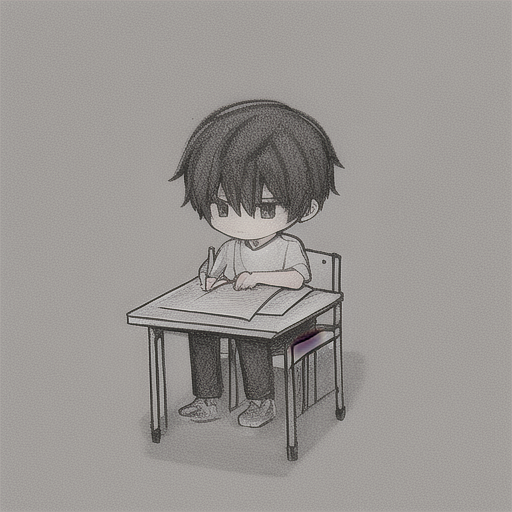
In June 2021, I made a decision: I would create my very first game and more specifically a yaoi visual novel. It all started when I stumbled upon the 2021 Yaoi Jam page on Itch.io. And like a fairytale, my game dev journey started.
This wasn't my first attempt at making a visual novel. In the past, I had tried to create visual novels with two different teams, only to see each project collapse when the team leads abandoned them. It was disheartening to witness everything crumble, with no one left to carry on those projects.
Drawing from my experience in project management from previous jobs, I knew I could step up as the project lead for this new endeavor. However, a leader without a team is powerless, so my first order of business was to start searching for a team.How my game dev journey started -- The story behind "The Prince's Heart".
 The home screen of "The Prince's Heart" visual novel.
The home screen of "The Prince's Heart" visual novel.Since visual novels are narrative-heavy games, I needed a capable writer. The first place that came to mind to search for one was r/WriteWithMe, a Reddit group dedicated to writing collaborations. Despite my initial doubts (that I wouldn't find anyone interested in making a visual novel game), I was fortunate enough to find a person willing to create the story for our game.
With a writer on board, I had solved the first part of the puzzle. Now my only challenge was to find an artist who could bring the character sprites and backgrounds to life. My next stop was r/INAT, a subreddit where you can find potential teammates to create video games. Finding one proved easier than expected, and after sending a few requests to a couple of 2d artists, I had a team ready to start the game.
Now the real challenge was about to start. As a writer and game dev, I knew the importance of balancing creativity with practicality. Video games aren't books; they require assets to be made from scratch, and if you don't set boundaries, it's easy to overwhelm the art team, which is why I asked the artist about the number of assets she could create over a period of two months. With this information in mind, I communicated it to the writer, so she knew what the restrictions were in terms of sprites and backgrounds: 8 sprites in various poses and 11 backgrounds. Even with these measures in place, it soon became apparent that the workload surpassed our initial estimates. The work was just too much for a single artist to complete in less than two months, so in the days that followed, I enlisted an additional background artist, an audio engineer and composer, a GUI artist, and a voice casting director from the VNdevs and BL discord groups to support us.
Despite all the additional support we got, it was becoming apparent that the game would take longer than expected, roughly twice the amount we had initially projected, for a number of reasons:The team consisted of junior game developers who were developing a game for the first time, so we underestimated how much time it would actually take to complete them.Our team was also participating in another jam, which I'm going into detail in the following section. It's a no-brainer that this would increase our workload, but at the time it seemed like a good idea to participate in a short jam because I wanted us to have another portfolio piece and boost the team's morale with a quick victory.We ended up releasing version 0.7 of The Prince's Heart by the end of the jam, which featured the complete story, voice-overs, and audio, but with flat-colored backgrounds and sprites. As it turned out, releasing the complete version would take us another 2 months of work to polish the assets and release the final version of the game.Lessons learned and contributing factors to delaysA key takeaway from my first experience as a project lead is the importance of maintaining a disciplined approach when it comes to defining the scope of your team's responsibilities. It is crucial to adhere to the agreed-upon assets from the outset and consider if further reduction is possible. Even the most seemingly insignificant alteration can trigger a domino effect, causing the project to spiral out of control.O2A2 Jam: Dragon Gazer -- The first game I completed was the second I started
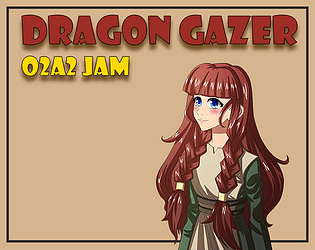 Dragon Gazer's promo artwork
Dragon Gazer's promo artworkO2A2 Jam was taking place during the Yaoi Jam. Unlike the Yaoi Jam where there's no restriction regarding the number of assets, word count, etc. O2A2 jam has several restrictions for the game devs (and trust me it was what we needed at the time).
Since O2A2 Jam lasts for only 1 week, the content needs to be no more than 1.000 words, and only 1 sprite, 1 bg, and 1 soundtrack is allowed, it's more likely to be completed. People tend to be more focused when something takes place for a few days, a couple of weeks at most (like a sprint). Due to the restrictions, game devs need to be creative enough to create a compelling story in a short amount of time. While the Yaoi Jam was taking place, we took a short break with the team to complete this one since it was short, and at the same time, it would boost motivation since the yaoi jam was a marathon. Eventually, we managed to complete the game in a few days. If I remember correctly, I submitted the game 4-5 days after the jam had started, and we were so excited we released our first game. This recharged our batteries to keep going with the Yaoi Jam.Lessons Learned from a short jamIf you're new, with a team you just met, jams that take place during the weekend or last up to two weeks are your best bet. If they succeed, you'll have a game to add to your portfolio, and if you fail, then you just lost a couple of weeks of work at worst.Fighting Grief by Developing multiple projects.
The events spanning from 2021 to 2022 will likely leave an indelible mark on my psyche for the rest of my days. Right after completing "The Prince's Heart," my father contracted COVID-19, and shortly after Christmas, he passed away. As if this blow wasn't enough, my grandfather succumbed to grief exactly two months later, on his birthday, in a cruel twist of fate. My grandmother's dementia worsened, and she lost touch with reality after my father's passing. Reflecting on the events of those two months and the hardships I endured still feels surreal to me. I won't delve into the specifics of the challenges faced during that time or the lingering unresolved matters they left behind – that's not the focus of this post. What kept me grounded amidst the chaos was my dedication to developing video games. Pouring myself into coding, writing, and game design served as a kind of therapy. Each new game project offered a refuge from the grief. I eagerly accepted every game dev offer that came my way. However, taking on too much eventually led to my downfall. I bit off more than I could chew, and the repercussions of my overloaded schedule would soon become evident.
I managed to release "The Prince's Heart" just days after my father fell ill with COVID-19. At that time, a fellow writer approached me with a request to adapt his Twine script into a visual novel (VN). This project presented a unique challenge due to its intricate branching narrative. While Twine made crafting complex narratives seem effortless, translating those intricacies into a visual novel engine posed its own set of challenges, from naming conventions to tracking branching paths using flags. On the bright side, creating assets for this VN was relatively straightforward, as Re:Shape was intended as a mobile game for Android – offering an opportunity to diversify our portfolio.
Given that many of my colleagues were junior developers, progress on our projects proceeded slowly, affording me the chance to engage in multiple tasks simultaneously. Consequently, I found myself juggling production, game design, writing, and programming duties. Production consumed a significant portion of my time, prompting me to explore joining another team, either as a programmer or designer. When I stumbled upon a newly formed group, I couldn't resist.
The project lead, a junior programmer, recognized my production skills and enlisted my help in organizing the team. When we settled on an idea, the project leader stepped back, leaving me in charge of production and design for "The Sinking of Dream Chaser." The challenge lay in using Unity, an engine I had little experience with. Despite internal struggles, I chose to continue with both projects simultaneously.
As my workload grew, I sought to lighten the burden by recruiting another programmer for Re:Shape, but with no success. Eventually, I coded the mobile game myself.
A year had passed, and my team and I had completed four games. The only game pending release was "The Sinking of the Dream Chaser," stalled in the programming department due to my unfamiliarity with Unity. Lacking the energy to learn a new engine, and with another Yaoi Jam approaching, I opted to start a new project, despite being a bad idea. Drawing from my experience crafting visual novels, I implemented strict guidelines akin to O2A2 Jam to ensure timely delivery. With a team of three artists, we divided the workload into manageable chunks. This phase of my game dev journey proved relatively smooth, given my experience and the project's manageable scope. In a stroke of luck, I recruited two additional programmers, one of whom was highly skilled, enabling us to complete "The Sinking of the Dream Chaser."
With 2022 coming to a close, I participated as a producer/programmer in a couple more projects that were successfully released.
I had finally released eight projects, and then it all came crashing down. I hit a wall.
My Unfinished Games: A Journey of AcceptanceNow I had three more games to finish: Calamity Sin, a 3D horror game with fixed camera angles reminiscent of the original Resident Evil 2; Town of the Damned, a sprawling visual novel boasting around 300k words; and Rogue Shifters, a Yaoi VN with gameplay elements, clocking in at approximately 50k (written by me).
Several factors contributed to these failures: the lack of programming support, scope creep in the first two projects, mainly due to the demands of parenthood. Mental pressure mounted from all sides, and I made the difficult decision to pull the plug. These games loomed large for a small team. Don't misunderstand me; I thrive on challenges and the desire to see projects through to completion. However, sometimes it's wiser to acknowledge failure and let go.
Reflections on my Game Dev JourneyBoth successes and failures have yielded valuable lessons. It's now clear to me which paths to steer clear of. Firstly, when faced with a complex project, it's wise to exercise caution, and having an experienced team or leader at the helm is a necessity. Secondly, I've discovered a preference for contributing to projects as a Technical Designer or Programmer, rather than assuming the roles of project lead or producer, opting to take a backseat instead.Going forward, I'm planning to release commercial games with a modest budget while maintaining a close-knit team, typically comprised of fewer than three members. Engaging in indie game development without financial backing can be both exhilarating and challenging, so it's important to always choose battles you can win.




